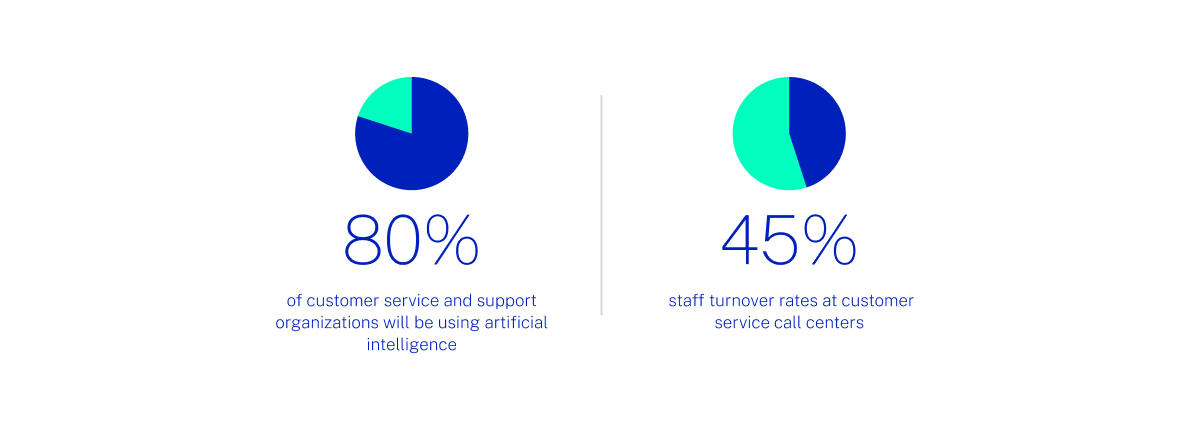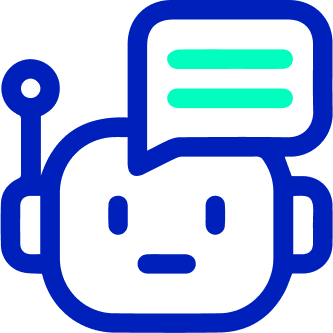Did you know that, by 2025, as many as 80% of customer service and support organizations will be using artificial intelligence to support customer experience? And did you know that working in a customer service call center is rated as one of the world’s most stressful jobs, with staff turnover rates of up to 45% a year?

All over the world, businesses are taking full advantage of AI to lighten the load on their customer service staff, expand their capacity for minimal extra outlay, and deliver the higher levels of service that customers increasingly expect. Of all the areas in which AI is developing, this is one that the public are already interacting with more than most. So if you aren’t already making the most of AI in a customer service capacity, there’s no time to lose in getting on board.
In this blog, we’ll take a close look at how Conversational AI and customer service come together: how it’s deployed in practice, how it’s helping redefine customer experience, and the breadth of industries that are benefiting from it.
What is Conversational AI and how is it used?
Conversational AI refers to tools that can simulate normal conversation by human beings. Natural Language Processing (NLP) means that human speech and text can be understood and processed by computers, who can then deliver responses to human input in ways that mimic people.
So far, there are three main types of Conversational AI tools that have gained traction in the area of customer service and experience:
 Virtual Assistants
Virtual Assistants
These are the text-based customer service platforms that are now commonplace on websites, apps, social media and messaging channels such as WhatsApp the world over. Any queries that are selected or typed in by users generate answers from the bot, which draws on previous learnings to generate the answer that will likely be the most helpful and relevant to the users.
When Virtual Assistants first emerged, they would respond to a small selection of predefined questions, often selected by users from a clickable list. But as Conversational AI has evolved, users are increasingly able to get responses effectively to unique and individual queries.
 Voice bots
Voice bots
Interactive Voice Response (IVR) systems have undergone significant evolution, transitioning from basic systems reliant on pre-recorded messages and dual-tone multi-frequency (DTMF) signaling to sophisticated voice bots. These modern voice bots leverage the latest in spoken language technologies, including speech synthesis, to offer voice-first experiences. They utilize a blend of retrieval-based and generative AI models to understand and process complex speech patterns. This advancement allows them to accurately interpret diverse accents, comprehend slang and industry-specific terminology, and function effectively even when call quality is less than ideal.
 Smart assistants
Smart assistants
There’s a good chance you already have a smart assistant in the comfort of your own home: Google Assistant and Amazon Alexa are just two of the AI-supported devices that are delivering integration and convenience for millions of people worldwide. These can be used in physical retail spaces, for example, by helping customers find products they’re interested in, or by guiding sales staff with information with which to help customers.
How is AI changing customer experience?
Artificial intelligence such as Conversational AI is changing the customer experience at breakneck speed. It was only around a decade ago that technology-led customer service extended to basic bots, website forms, and some rudimentary elements of automated support.
Today, customer service is expected to be fast, intuitive, and omnichannel across phone, email, apps, web chats, video calls, social media and much more. Customers that don’t get that level of service will quickly become dissatisfied and driven towards competitors, which is why AI is proving so important to delivering on those ever-rising expectations.
Areas where Conversational AI is making the biggest difference include:
 Quicker responses
Quicker responses
Customers are increasingly unwilling to accept waiting days or even hours for written responses to their queries - or to be left on hold on the phone for several minutes. They want answers to their problems, and they want them now.
Using Conversational AI can make the process of issue resolution faster in two different ways. The first is that technologies like Virtual Assistants and voice bots can instantly process customer information and generate responses, at a volume and scale many times greater than a human customer support team could handle.
The second is that AI can also be used to help support staff resolve issues faster by getting quick information on common or repetitive issues. It’s no surprise that Salesforce research has found that 63% of service professionals say AI can help them serve customers faster.
 Personalization
Personalization
There is a gap in perception between the personalization that customers expect, and what many businesses are providing. According to Segment, 85% of businesses feel they provide personalized experiences, but only 60% of customers agree.
From a customer service perspective, this means that customers expect to be treated and valued as individuals, so the cookie-cutter responses of old chatbots aren’t going to cut it anymore. AI has an instrumental role to play in delivering personalization in this area, analyzing previous trends and behaviors from the customer, including any past interactions, and delivering responses in the correct context.
 Identifying opportunities for upselling
Identifying opportunities for upselling
Connected to the previous point, the individual customer data that AI can access can be extremely valuable in sparking customer interest in other products and services that they might be interested in. Knowing what a customer likes, what they’ve browsed and what they’ve bought in the past allows them to be matched with relevant products, and targeted with messaging and offers on that basis. The text and speech-based conversations that customers have with Virtual Assistants and voice bots are excellent data points for enabling this.
 Always-on support
Always-on support
Behind the scenes, Conversational AI is making customer service a much more efficient endeavor, and one that can now run 24/7 in a much more cost-effective way. For example, the ability for repetitive tasks to be automated, and for Conversational AI to deliver information that can better inform the work of the customer support team. Additionally, Virtual Assistants and voice bots can operate all the time, meaning customers don’t have to wait until normal office hours to speak to a human being - and businesses don’t have to pay extra to employ a customer support team on a night shift.
Which industries could benefit from Conversational AI for CX?
Customer service is now vital for every single consumer-facing industry, and it’s clear that Conversational AI has a major part to play in that. In particular, we see opportunities for Conversational AI deployments to transform four sectors in particular:
How to use Conversational AI in finance
The banking sector is one where customers can often get frustrated from a customer service perspective, and so finance firms are using Conversational AI to improve service provision.
This can include intelligent call routing so that customers are quickly connected to the right people to handle their queries; delivering more personalized services and offers, including upselling based on customer data; using natural conversation for security and authorization; and handling standard queries such as branch opening times or PIN reminders.
How to use Conversational AI in retail
Conversational AI is enabling a far greater scale of service in the retail industry, and the ability to do so 24/7. For example, one of the most common queries a customer will make is to track down an order they’re waiting for: using a Virtual Assistant users can track down this data and inform the customer of the situation in a matter of seconds.
Similarly, Conversational AI can also oversee billing and payment processes, either online or over the phone; answer queries such as store opening hours and product information; and deliver personalized offers and upselling opportunities.
How to use Conversational AI in hospitality
When people come to hospitality businesses like hotels and restaurants, they expect the very best in customer experience from the moment they book to the moment they leave, and everything in between.
Conversational AI can take care of entire booking, reservation and pre-payment processes, meaning customers can complete these processes straight away without having to wait for a staff member. This can also extend to making food orders for delivery or takeaway, or arranging concierge service. There are also a range of possibilities for upselling and cross-selling, whether it’s better tables, upgrades on rooms or package discounts.
How to use Conversational AI in iGaming
In the highly-competitive iGaming industry, the demand for hyper-personalization is coming to the fore, with players expecting more games, offers and experiences that are tailored to their preferences. Conversational AI is enabling a whole range of new innovations, such as in-game conversations that closely mimic person-to-person chats, and personalized gaming assistance to support smoother experiences. Perhaps even more importantly, it can also be used to spot patterns of problem gambling behavior, or some of the signs that lead to it, and step in with proactive interventions that support healthy and safe play.

Maximize Conversational AI with Ciklum
So how can you explore Conversational AI customer service, and make sure that your organization is using the latest innovations and technologies?
At Ciklum, we work every day with businesses just like yours, across finance, iGaming, retail and many other sectors, making their Conversational AI deployments the best they possibly can be. Through a combination of cutting-edge innovation, a strong focus on experience design, and a holistic approach to development, we can help you make your customer service faster, more efficient, more personalized and more cost effective than ever before. What’s more, an ongoing partnership means we can constantly bring new capabilities to the fore, and turn your customer service into a genuine driver of competitive advantage.
Find out more on how Ciklum can help you harness the power of Conversational AI here, or talk to our team to discuss your specifics.

































